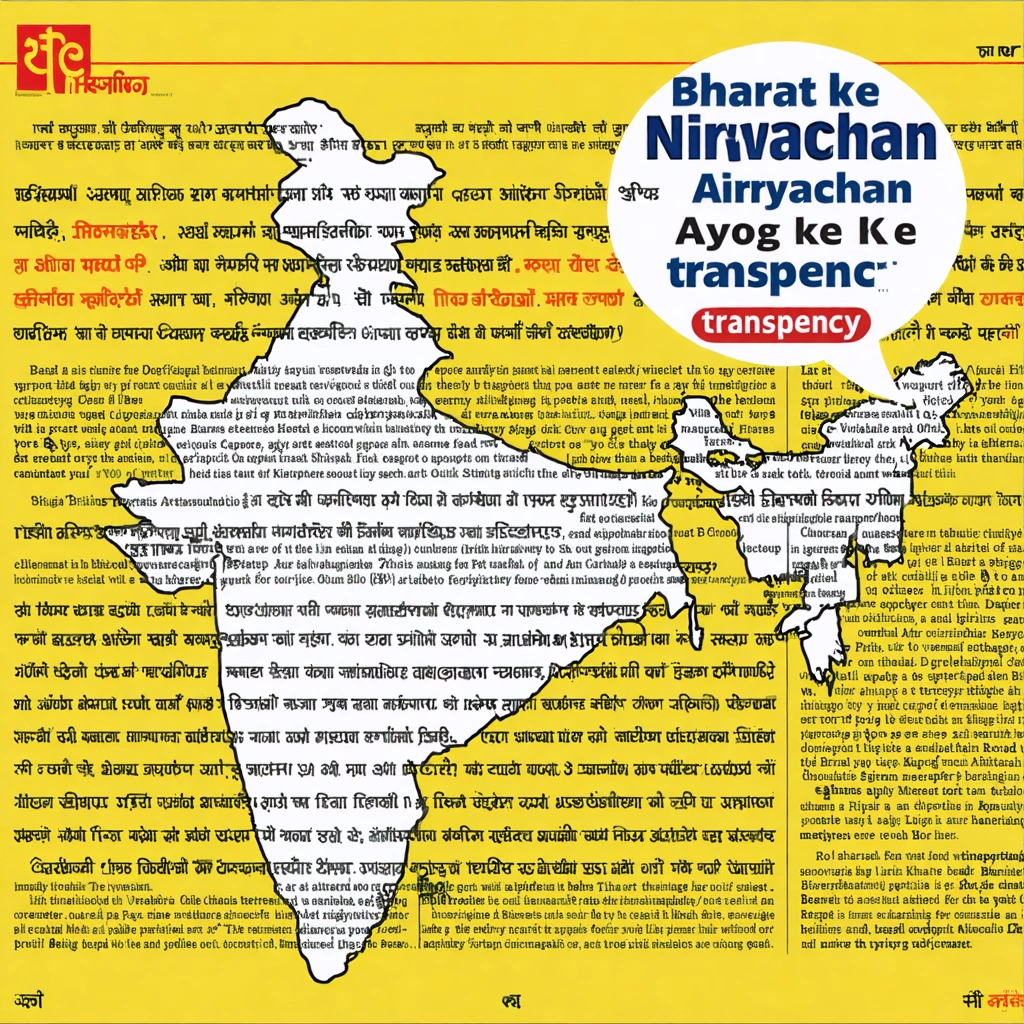Why Transparency in India’s Electoral Process Matters More Than Ever
Imagine standing in a voting booth, ready to cast your ballot, but unsure if your vote will truly count or be fairly counted. This uncertainty gnaws at the very foundation of democracy. In a country like India, where over 900 million voters participate in elections, the integrity of the electoral process isn’t just a bureaucratic concern—it’s a matter of public trust and national identity. As we approach the pivotal elections of 2025, questions surrounding transparency have never been more urgent.
The term Bharat Ke Nirvachan Aayog Ke Transparency embodies the idea of openness and clarity in the Election Commission of India’s operations. It’s not just a slogan but a critical yardstick for evaluating how elections are conducted, ensuring that every citizen’s voice is heard without interference or doubt. Yet, despite numerous efforts, skepticism persists among voters, analysts, and civil society organizations alike.
Why do such doubts linger? How does the Election Commission address these challenges? And what new transparency measures are being introduced to bolster faith in India’s democratic machinery? In this article, we will delve deep into the heart of these questions, unpacking the layers of electoral transparency initiatives, including key documents like the Bharat Ke Nirvachan Aayog Ke Transparency PDF, which provide accessible, detailed insights into the Commission’s strategies and reforms.
From Doubt to Confidence: Navigating the Complexities of Electoral Transparency
It’s easy to assume that with modern technology and decades of experience, electoral transparency would be a given. But reality paints a more complex picture. For starters, India’s vast and diverse electorate poses unique challenges—spanning from remote villages to bustling metros, each with varying levels of digital literacy and access to information.
Moreover, transparency is not simply about making information available; it’s about making it understandable and trustworthy. The Election Commission’s initiatives, often encapsulated under the banner of Bharat Ke Nirvachan Aayog Ke Transparency in Hindi, aim to bridge this gap by providing resources in regional languages, ensuring that transparency is not confined to legal jargon but reaches the heart of every voter.
Consider the flood of misinformation and distrust that has occasionally marred previous elections. Without clear, consistent communication and accessible data, rumors can spiral out of control, eroding confidence in the electoral process. The Election Commission’s transparency measures, therefore, are not just administrative tools—they are vital defenses against the corrosion of democratic integrity.
So what does this look like in practice? The Bharat Ke Nirvachan Aayog Ke Transparency PDF is a treasure trove of information, detailing everything from candidate affidavits to expenditure reports and the deployment of cutting-edge electronic voting machines (EVMs). These documents are designed to be publicly accessible, empowering citizens, journalists, and watchdog organizations with the knowledge they need to hold the system accountable.
What You Can Expect From This Article
In the sections that follow, we will explore:
- The key transparency initiatives launched or enhanced by the Election Commission for the 2025 electoral cycle.
- How the Commission leverages technology and public engagement to promote openness.
- The role of official publications, including the invaluable Bharat Ke Nirvachan Aayog Ke Transparency PDF, in informing and educating voters.
- Challenges that remain and the ongoing dialogue between the Election Commission, political stakeholders, and the electorate.
Whether you are a concerned citizen, a political analyst, or simply curious about how one of the world’s largest democracies safeguards its electoral process, this article offers a comprehensive guide to understanding the transparency measures shaping India’s elections in 2025.
Transparency is the lifeblood of democracy. By unpacking the efforts of India’s Election Commission under the lens of Bharat Ke Nirvachan Aayog Ke Transparency, we hope to illuminate how openness is not only an ideal but an actionable reality—one that can inspire greater voter confidence and a more vibrant democratic future.

Electoral Systems’ Transparency Measures: Exploring Transparency in India’s Electoral Systems for 2025
As India approaches the 2025 electoral cycle, transparency in electoral processes has become a paramount concern for voters, political analysts, and governance bodies alike. Understanding the various transparency measures implemented by the Election Commission of India—referred to as Bharat Ke Nirvachan Aayog Ke Transparency—is essential for ensuring free, fair, and credible elections. This article delves deeply into these transparency initiatives, providing a clear, comprehensive insight into how the electoral system is becoming more open and accountable.
What Are the Key Transparency Measures Adopted by Bharat Ke Nirvachan Aayog?
The Election Commission of India has consistently enhanced transparency to curb malpractices and build voter confidence. Some of the critical transparency measures include:
- Real-Time Election Expenditure Monitoring: Candidates and political parties are required to declare their campaign expenses regularly. The Commission has introduced digital tools to track these expenses in real time, helping prevent overspending and unlawful funding.
- Public Disclosure of Candidate Information: Comprehensive affidavits disclosing criminal records, assets, liabilities, and educational qualifications are made publicly available before elections, enabling informed voter decisions.
- Use of Electronic Voting Machines (EVMs) with VVPAT: The integration of Voter Verifiable Paper Audit Trail (VVPAT) with EVMs adds a layer of transparency by allowing voters to verify their vote was recorded correctly.
- Transparent Voter Registration and Electoral Rolls: Continuous updating of electoral rolls and easy online access to voter registration status have minimized errors and fraudulent entries.
- Deployment of Observers and Use of Surveillance Technology: Independent election observers and the use of CCTV cameras at polling stations ensure adherence to guidelines and deter malpractice.
How Can One Access Bharat Ke Nirvachan Aayog Ke Transparency Documents?
For researchers, journalists, and citizens who want to study these measures in detail, the Election Commission provides comprehensive resources, often compiled in PDF format. The Bharat Ke Nirvachan Aayog Ke Transparency PDF documents include notifications, guidelines, expenditure reports, and audit summaries, which are accessible via the official Election Commission website.
These PDFs serve as an official repository of transparency measures, allowing stakeholders to verify data, understand procedural updates, and track the Commission’s efforts toward electoral integrity. Typically, these documents are updated regularly, especially as election dates approach.
Why Is Bharat Ke Nirvachan Aayog Ke Transparency Important for Indian Democracy?
Transparency is the backbone of any democratic electoral system. In India’s vast and diverse context, electoral transparency serves several critical functions:
- Building Trust: Transparent processes reduce suspicion among voters, political parties, and civil society, fostering trust in electoral outcomes.
- Preventing Electoral Fraud: Open disclosure of candidate details and expenditure monitoring helps curb corruption and illegal funding.
- Empowering Voters: Access to information enables voters to make informed choices based on candidates’ backgrounds and campaign conduct.
- Ensuring Accountability: Transparency holds candidates and officials accountable to the public and legal frameworks.
India’s commitment to enhancing electoral transparency is a major reason why its elections are globally recognized as robust and credible, despite the country’s enormous scale and complexity.
Where Can One Find Bharat Ke Nirvachan Aayog Ke Transparency Resources in Hindi?
Given the wide linguistic diversity in India, the Election Commission ensures that information on transparency measures is also available in Hindi, the most widely spoken language in the country. The Bharat Ke Nirvachan Aayog Ke Transparency in Hindi materials include:
- Election guidelines and manuals translated into Hindi for accessibility.
- Hindi versions of candidate affidavits and expenditure reports.
- Public awareness campaigns and voter education programs conducted in Hindi.
- Official Hindi PDFs available on the Election Commission’s portal to facilitate easy understanding by the Hindi-speaking electorate.
This multilingual approach significantly enhances transparency by ensuring that language is not a barrier to accessing critical electoral information.
Case Study: Impact of Transparency Measures in the 2019 General Elections
The 2019 General Elections in India demonstrated the positive impact of enhanced transparency measures:
- Increased Disclosure Compliance: Over 90% of candidates submitted detailed affidavits and expense reports, which were publicly accessible.
- VVPAT Integration: VVPAT machines were used in all constituencies, enhancing voter confidence and enabling audits in case of disputes.
- Digital Monitoring: The Commission’s expenditure monitoring portal flagged suspicious spending patterns, resulting in scrutiny and penalties.
These measures contributed to a transparent and smooth election process despite record-breaking voter turnout, setting a benchmark for future elections, including the 2025 cycle.
Preparing for 2025: What Further Transparency Enhancements Can We Expect?
Looking ahead to the 2025 elections, the Election Commission is focusing on:
- Enhanced Use of Technology: Artificial intelligence and data analytics to detect anomalies in voter rolls and campaign finance.
- Greater Public Participation: Platforms for citizens to report violations and access real-time election information.
- Stricter Enforcement: Tighter legal frameworks to penalize violations of transparency norms.
- Expanded Multilingual Support: More robust dissemination of information in regional languages beyond Hindi to reach all voter demographics.
These initiatives aim to deepen the transparency ecosystem, making Indian elections even more resilient and trustworthy.
Conclusion
Understanding Bharat Ke Nirvachan Aayog Ke Transparency and its associated resources like the Bharat Ke Nirvachan Aayog Ke Transparency PDF and Hindi materials is vital for anyone interested in India’s democratic processes. Transparency measures not only safeguard electoral integrity but also empower voters and strengthen democracy. As we approach the 2025 elections, staying informed about these measures will help citizens participate more actively and confidently in the electoral process.




